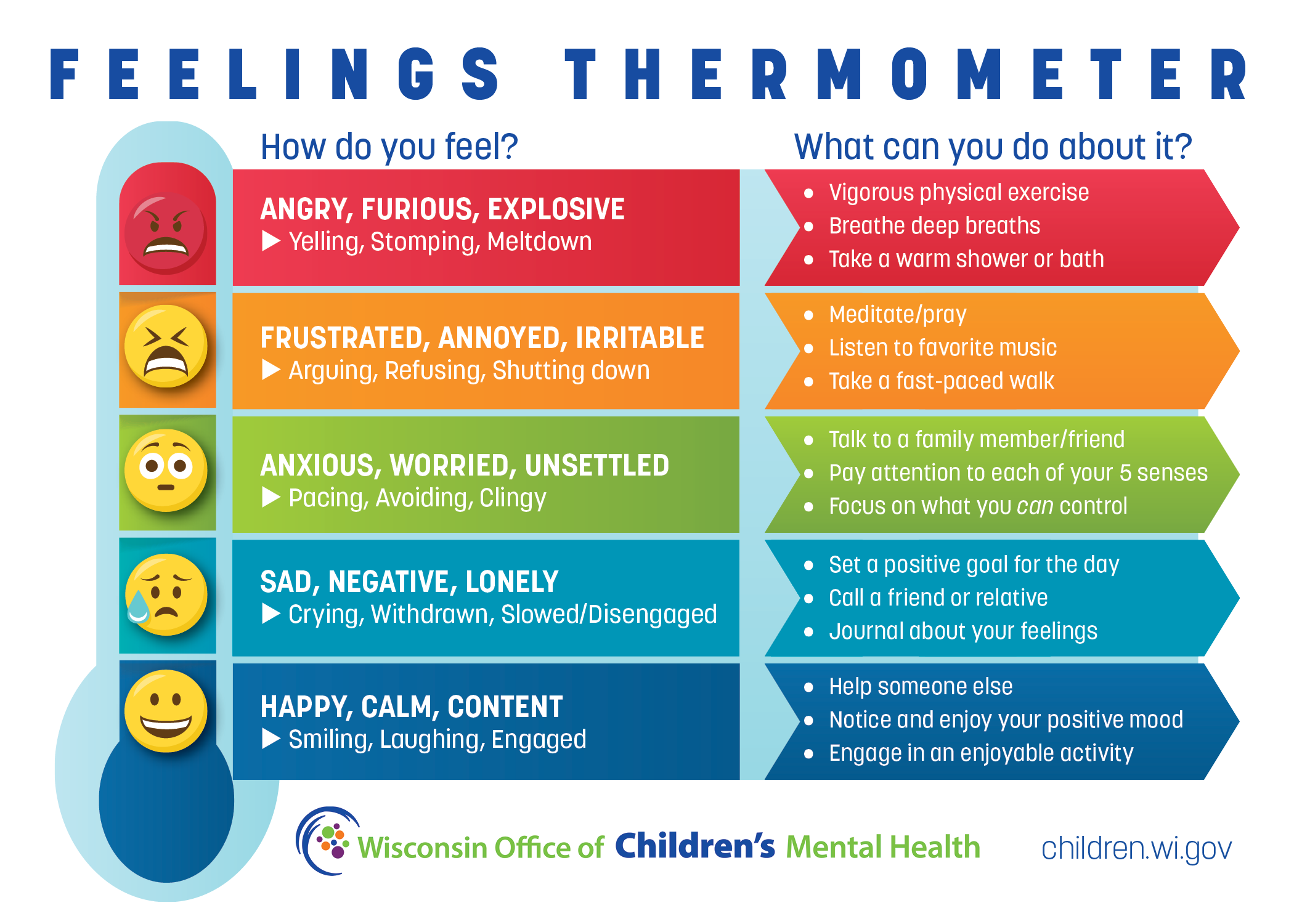
![]()
"Working as a family to identify feelings, reduce anxiety, and find balance
will help everyone feel better." - First Lady Kathy Evers
What is the Feelings Thermometer?
The Feelings Thermometer is a visual tool that helps you (kids and adults) measure how you are doing emotionally and what steps you can take to shift your mood when things are getting tough.
How you can use the Feelings Thermometer
Like a temperature thermometer, the Feelings Thermometer shows you when your emotional temperature is getting warmer and then hotter, to potentially dangerous degrees. It starts at blue – the calm zone, and goes to red – the furious zone. Throughout the zones it lists activities to feel less angry, frustrated, anxious, and sad.
How it works
Research shows that just identifying a calming activity can reduce anxiety. Being aware of your feelings is the first step!
*NEW* Customize your own strategies on the Feelings Thermometer
This version leaves space for you to write in the things that you know work for you! Do this as a family or with your friends to learn what helps each other shift emotions and feelings. Print the customizable English Feelings Thermometer!
Using the Feelings Thermometer
Parents, teachers, school social workers and children can all make use of the Feelings Thermometer. In addition to the thermometer, we also provide a short handout which explains how to use this tool and offers conversation starters.
Download and print a feelings thermometer to post on your fridge or in a common area.
English Feelings Thermometer + How to Use
Arabic Feelings Thermometer + How to Use
Burmese Feelings Thermometer + How to Use
Dari Feelings Thermometer + How to Use
Hmong Feelings Thermometer + How to Use
Karen Feelings Thermometer + How to Use
Ojibwe Feelings Thermometer + How to Use
Pashto Feelings Thermometer + How to Use
Somali Feelings Thermometer + How to Use
Spanish Feelings Thermometer + How to Use
Swahili Feelings Thermometer + How to Use
Parents / Grandparents / Aunts & Uncles
Check the emotional temperature of the children in your family:
-
Post the Feelings Thermometer on your refrigerator
-
After school, while making dinner, other moments when you are in the kitchen, use it to guide a simple conversation about the importance of paying attention to feelings
Talking about Feelings. With the Feelings Thermometer posted, ask children questions like:
-
Which zone are you in right now? What in your body tells you that you are in that zone?
-
What can you do to move to the blue zone?
-
Have you used any of the strategies on the Feelings Thermometer?
-
What works for you when you are in the red zone?
-
How could you help someone in the green zone?
-
Name another activity that works to move you from the orange zone to the blue zone.
-
Would there be a good time of day for the whole family to check their Feelings reading?
-
Which activities would help others in the family to stay in the blue, calm zone?
For some, identifying feelings is not easy. Encouraging children to identifying feelings is good. It may take some practice for them to connect the feeling with words to describe it. If they can't do it right away, take a break and come back to it later.
Teachers / School Social Workers
Check the emotional temperature of your students:
-
Screen share it at the start or end of your class/meeting to check in on how students are feeling
-
Share the five feeling levels in Kahoot, PollEverywhere, or another poll platform and ask students to identify which zone they are in
-
Change your virtual background on Zoom to the Feelings Thermometer
-
Use it to guide conversation in home room, study hall, advisory, individual therapy sessions, or 1 on 1 check in's with students
Talking about Feelings. With the Feelings Thermometer posted, ask students questions like:
-
What can you do right now to move to the blue zone?
-
Have you used any of the strategies on the Feelings Thermometer?
-
What works for you when you are in the red zone?
-
How could you help someone in the green zone?
-
Name another activity that works to move you from the orange zone to the blue zone.
Encourage students to share the thermometer with their parents and have them use it at home to help the whole family stay in the happy/calm zone.
Children
-
Post the Feelings Thermometer on your refrigerator
-
At breakfast, in the afternoon, at dinner or any other time think about how you are feeling. Are you happy (blue)? Are you worried (green)?
-
Is there someone you can talk to about your feelings?
-
Do you want to feel happy? Do you see an activity in the What You Can Do column that might help you feel better? Try it out and see if it works!
-
If you are already happy/smiling/laughing, can you share your feelings with someone else in your family to brighten their mood?
The Office of Children's Mental Health would like to thank for guidance in the development of this Feelings Thermometer Dr. Marcia Slattery, MD, MHSc, Professor of Psychiatry and Pediatrics at the University of Wisconsin School of Medicine and Public Health. Dr. Slattery is the Director of the UW Anxiety Disorders Program for children, adolescents and adults. She specializes in the clinical assessment and treatment of anxiety and stress, especially in children and adolescents.
If you have difficulty accessing our materials, or using our website, please let us know by emailing OCMH@wi.gov.
We take digital accessibility seriously and welcome the opportunity to remove any barriers in accessing content.